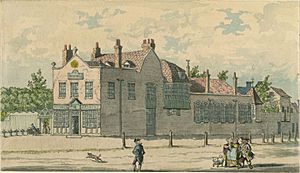John Bevis facts for kids
Quick facts for kids
John Bevis
|
|
|---|---|
| Born |
John Bevis
10 November 1695 |
| Died | 6 November 1771 (aged 75) |
John Bevis (born November 10, 1695, in Salisbury, Wiltshire – died November 6, 1771) was an English doctor, scientist, and astronomer. He is famous for discovering the Crab Nebula in 1731.
John Bevis went to Christ Church, Oxford university. He earned his first degree in 1715 and a master's degree in 1718.
In 1757, Bevis wrote a book called The History and Philosophy of Earthquakes. In this book, he gathered many true stories about the 1755 Lisbon earthquake. His work was the first of its kind. Later, another scientist named John Michell used Bevis's research.
Also in 1757, a man named Thomas Hughes asked Bevis for help. Hughes was a tobacconist and wanted to know why no flowers would grow in his garden. The garden was at Bagnigge House in London. Bevis found that the water from the well there had a lot of iron.
Because of this, a second well was dug. The water from this new well was good for health. This led to the creation of Bagnigge Wells, a very popular spa in the 1700s. In November 1765, John Bevis became a Fellow of the Royal Society. This is a special group for important scientists.
Exploring Electricity
When the Leyden jar first came to the UK in 1746, Bevis worked with William Watson. They made the Leyden jar better. First, they took out the water and put in lead shot. Later, they lined the inside and outside of the glass with lead.
They also did experiments to find out how fast electricity moves. They used almost four kilometers (about 2.5 miles) of wire. They watched the spark when electricity entered the wire and when it left. They could not see any delay. They decided that electricity must move almost instantly.
Watson and Bevis often wrote letters to Benjamin Franklin and his team in America. Together, they made many discoveries:
- They improved the Leyden jar by covering it with tin foil.
- They connected Leyden jars to create a "battery."
- They learned the difference between connecting jars in a line (series) and side-by-side (parallel).
- They made the first flat-plate condenser, which was like a flat Leyden jar.
- They created the "single-fluid theory" of electricity. This idea said that electricity was like a fluid. Too much fluid in one place meant a positive charge. Not enough fluid meant a negative charge.
Star Gazer and Map Maker
John Bevis is known for discovering the Crab Nebula in 1731. This is a cloud of gas and dust in space. It was later listed as M1 in a famous catalog of sky objects.
He also watched Venus pass in front of Mercury on May 28, 1737. This event is called an occultation. Bevis also studied the eclipses of Jupiter's moons. He even found a way to predict when these eclipses would happen.
Bevis wanted to create a new star map for Britain called Uranographia Britannica. He first announced this project in a newspaper in 1748. He told people they could get copies when it was finished.
His star map was based on older star positions from a book called Historia Coelestis Britannica. Bevis also added new stars that he observed himself. He made these observations between 1738 and 1739 from Stoke Newington. Uranographia Britannica was special because it was one of the first star maps to include objects that were not just stars, like the Crab Nebula.
Sadly, in 1750, Bevis's publisher went bankrupt. The metal plates used to print the maps were taken by the courts. So, Uranographia Britannica was never fully published.
Years later, in 1785, after Bevis had died, his books and papers were sold. Three almost-finished copies of Uranographia Britannica were sold. Also, many star charts were put together and sold in 1786 as Atlas Celeste. This atlas was not as complete as Bevis had planned. It did not have his notes or star lists.
Today, we know where all three of Bevis's original Uranographia Britannica copies are. One is in Philadelphia, USA. Another is at St John's College, Cambridge in the UK. The third was found in 2011 at Chatsworth House in the UK. We also know where most of the Atlas Celeste copies are.
The Manchester Astronomical Society in the UK has a website about Bevis's star charts.
His Final Years
John Bevis died in 1771. He passed away after falling from his telescope.
See also
 In Spanish: John Bevis para niños
In Spanish: John Bevis para niños


